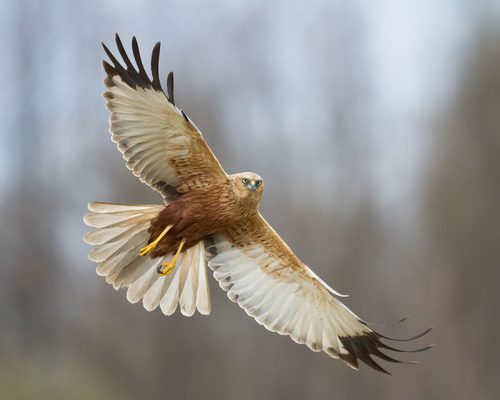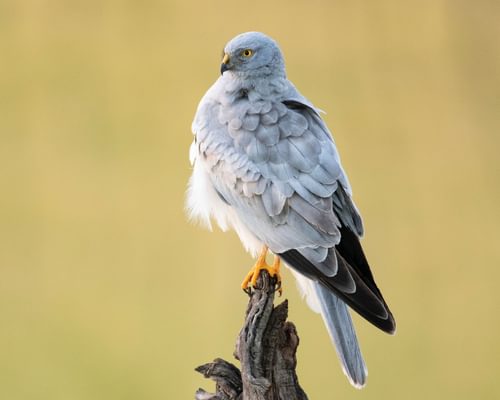African Marsh Harrier
Least ConcernCircus ranivorus
Visual Identification
Appearance
The African Marsh Harrier is a medium-sized raptor with a distinctive owl-like facial disc. Adults have rich brown plumage, black wing tips and a pale rump patch. The tail is barred with dark bands, and the legs are long and yellow.
Males are generally lighter in colour than females, with more distinct pale streaking on the breast and underwings. Juveniles resemble females but have a more uniform brown colouration and lack the barred tail of adults.
Size
Length
44cm to 52cm
Wingspan
100cm to 120cm
Weight
400g to 600g
Colours
Males and females have similar plumage
Primary Colour
Brown
Secondary Colour
Black White
Beak Colour
Black
Leg Colour
Yellow
Habitat and Distribution
Habitats
Woodland
Garden
Wetland
Coastal
Urban
Farmland
Grassland
Desert
Tundra
Rainforest
Mountain
Savanna
Distribution
African Marsh Harriers are found throughout sub-Saharan Africa, from Senegal east to Ethiopia and south to South Africa. They inhabit various wetland habitats, including marshes, swamps, and flooded grasslands.
While primarily resident, some populations may undertake local movements in response to changing water levels or food availability. They are absent from densely forested areas and true deserts, preferring open landscapes with abundant water sources.
Elevation Range
Sea level to 3,000 meters
Climate zones
Tropical, Subtropical
Distribution Map
This map gives you a rough idea of where you might spot a African Marsh Harrier. The coloured areas show countries where these birds have been seen.
A few things to keep in mind:
- Birds might not be everywhere in the coloured areas, for example, they may be present around the coast of that country
- Where birds live can change with seasons and available food
- This map is quite simple - it doesn't show exact locations
We're working on making our maps even better! Soon, we hope to show you:
- More detailed maps for bigger countries, including state and region
- How birds move around during different seasons
Distribution by Region
Behaviour and Ecology
Bird Attributes
This feature is in beta. We'd love your feedback to improve it!
Share your thoughtsBird Attributes Explained
Our bird attributes system rates various aspects of a bird's capabilities on a scale of 0-100, based on data from field observations, scientific studies, and expert knowledge.
Attribute Categories:
- Agility: Manoeuvrability, speed, and grace in flight or movement.
- Strength: Physical power, often correlating with size and hunting abilities.
- Adaptability: Ability to thrive in various environments or changing conditions.
- Aggressiveness: Territorial behaviour and assertiveness, particularly during breeding seasons.
- Endurance: Stamina, often seen in migration patterns or foraging behaviours.
Understanding the Ratings:
- 0-20: Very Low
- 21-40: Low
- 41-60: Average
- 61-80: High
- 81-100: Very High
Remember, these attributes are relative to other bird species and don't necessarily indicate superiority.
Hover over the icon next to each attribute for more information.
Tap the icon next to each attribute for more information.
Agility
Reflects the bird's manoeuvrability, speed, and grace in flight or movement.
The African Marsh Harrier displays remarkable agility in its low, quartering flight over wetlands and grasslands. Its ability to manoeuvre swiftly through reeds and vegetation whilst hunting demonstrates high-level aerial prowess.
Strength
Indicates the bird's physical power, often correlating with size and hunting abilities.
As a medium-sized raptor, the African Marsh Harrier possesses considerable strength for its size. It's capable of carrying prey such as small mammals and birds, indicating robust physical power.
Adaptability
Represents the bird's ability to thrive in various environments or changing conditions.
This species shows impressive adaptability, thriving in various wetland habitats from sea level to 3000 metres elevation. Its diverse diet, including mammals, birds, reptiles, and even insects when necessary, further showcases its adaptable nature.
Aggressiveness
Measures the bird's territorial behaviour and assertiveness, particularly during breeding seasons.
While not overly aggressive, African Marsh Harriers exhibit territorial behaviour during breeding season. Males perform spectacular aerial displays, and both sexes defend their nesting areas, suggesting a moderate level of aggression when required.
Endurance
Reflects the bird's stamina, often seen in migration patterns or foraging behaviours.
The African Marsh Harrier's ability to engage in prolonged, low-altitude flights whilst hunting indicates good endurance. Its potential to undertake local movements in response to changing conditions also suggests a respectable level of stamina.
Diet
The African Marsh Harrier is a versatile predator, feeding primarily on small mammals, birds, and reptiles.
They are particularly adept at catching frogs and fish, swooping down to snatch prey from the water's surface or vegetation. When other food sources are scarce, their diet may also include insects and carrion.
Behaviour
African Marsh Harriers are known for their low, slow flight pattern. They quarter over marshes and grasslands in search of prey.
They are often solitary but may gather in loose groups during the non-breeding season. These harriers are territorial during breeding, with males performing spectacular aerial displays to attract mates.
Vocalisation
The African Marsh Harrier is generally silent outside of the breeding season. During courtship and territorial displays, males produce a series of sharp, repetitive 'kek-kek-kek' calls. Females may respond with a softer, mewing sound.
When alarmed, both sexes emit a harsh, grating 'kraaak' call.
Nesting & Breeding
Breeding season for African Marsh Harriers typically occurs from July to December, varying slightly across their range. Males perform elaborate sky-dancing displays to attract females, involving steep climbs and dives accompanied by calls.
Nests are built on the ground or in dense vegetation over water, constructed of reeds, grasses, and small sticks. Females lay 3-5 pale blue eggs, which may be speckled with brown.
Incubation lasts about 30-34 days, primarily by the female. Chicks fledge after 35-40 days but remain dependent on their parents for several more weeks as they learn to hunt.
Lifespan
years
The African Marsh Harrier typically lives for 10 to 15 years.
Like all birds, lifespan can be affected by factors including predation, habitat quality, disease, and access to food sources.
Conservation and Status
Global Conservation Status
While currently listed as Least Concern, the African Marsh Harrier faces threats from habitat loss due to drainage of wetlands and agricultural expansion.
Conservation efforts focus on protecting and restoring wetland habitats across its range to ensure the species' long-term survival.
Population Data
Global Population Estimate
Unknown
Birdwatching Tips
- Look for their characteristic low, wavering flight over wetlands and grasslands
- Listen for their distinctive 'kek-kek-kek' call during breeding season
- Observe them in early morning or late afternoon when they are most active
- Check for their roosting sites in tall reeds or grasses
Additional Information
Quick Facts
Other names:
Ranivorus Harrier
Family:
AccipitridaePredators
Did You Know?
- African Marsh Harriers have excellent hearing, which helps them locate prey in dense vegetation.
- They are one of the few harrier species that do not typically migrate long distances.
- These birds are crucial in controlling rodent populations in agricultural areas near wetlands.
Was this bird profile helpful?
Your feedback helps us improve our content
Thanks for your feedback!
Your input helps us improve our content.
Community Experience
Community Ratings
No ratings yet - be the first to rate this bird!
Latest Community Reviews
No reviews yet
Sign in to be the first to review
Community Reviews
Create Your Free Account Welcome Back!
Join our community to rate birds and share your experiences. Creating an account is completely free and only takes a minute. Sign in to your account to rate birds and share your experiences with our community.
Your information is secure and will never be shared.
By creating an account, you agree to our Privacy Policy.
Similar Birds
References
- 1 2
website: BirdLife International. 2016. Circus ranivorus. The IUCN Red List of Threatened Species 2016: e.T22695352A93504602. Accessed on 30 August 2024.
View source

